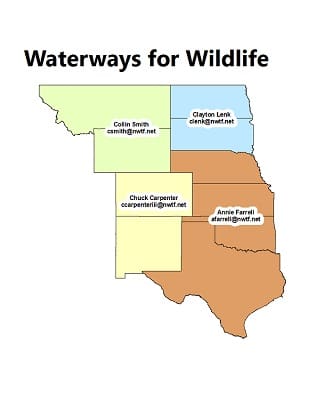Critical Investment in Water-Related Conservation Projects Forthcoming

EDGEFIELD, S.C. — For the third year, the NWTF’s Waterways for Wildlife Initiative is opening up funding opportunities for projects that occur in riparian (water-related) systems benefitting wildlife and water resources within the initiative’s ten-state region (see map below).
“We have set ambitious goals for our Waterways for Wildlife Initiative,” said Jared McJunkin, NWTF director of conservation operations for the central region. “But with our dedicated partners, we are making significant progress in both conserved acres and stream miles in Great Plains’ riparian habitats. We are looking forward to our heightened impact in 2024.”
In 2022, the NWTF’s Waterways for Wildlife Initiative, with partner match, allocated $2.8 million to its first 14 conservation projects. A year later, the NWTF and partners added 20 additional projects under the Waterways for Wildlife umbrella with a $5.3 million collaborative investment.
For 2024, the landscape-scale initiative is again accepting applications for financial assistance in support of vital projects that improve wildlife habitat in riparian systems. Projects with a direct benefit to water conservation are highly encouraged, and proposals that expand the long-term or large-scale restoration of riparian ecosystems are also encouraged.
Eligible parties for funding in 2024 include federal, state and local agencies and entities, conservation organizations, colleges/universities and private landowners currently working through an existing recognized federal, state or locally sponsored conservation assistance program.
Application forms can be found here. Completed applications should be sent to w4wapplications@nwtf.net.
Project proposals will be ranked and scored by the NWTF’s Waterways for Wildlife Initiative staff on the applicability of the projects, conservation impact, partner engagement and matching funds, among other criteria.
The Conservation Need
Riparian ecosystems are naturally diverse systems subject to frequent periods of flooding and drought. These natural disturbances serve to create new seed beds and remove biomass, ultimately “setting back” plant succession and providing nutrients to riparian plant communities which maintains a productive ecosystem that benefits wildlife species. However, many changes have occurred in the Great Plains that have disrupted this natural cycle and impacted the health of these vital communities. Land use changes (including altered hydrology), increased water demands to meet human needs, invasive species and livestock impacts are some of the many factors that can affect riparian ecosystem function and diminish wildlife habitat.
Riparian areas are a natural magnet for wild turkeys and hundreds of other wildlife species. These areas are also crucial for fish and other aquatic species, as they help control erosion and filter excess nutrients and chemicals from surface runoff that can adversely affect spawning and rearing areas. Riparian areas also control flooding, improve water quality and provide for community and agricultural water supply demands while recharging underground aquifers.
Over the course of 10 years, the initiative has set the goal of enhancing 1,500 stream miles and 75,000 acres of riparian-related habitat within 10 Great Plain states. Waterways for Wildlife projects vary in how they benefit water conservation and wildlife, from removing invasive species to reconnecting floodplains. View completed and ongoing Waterways for Wildlife projects.
Learn more about riparian ecosystems and the NWTF’s Waterways for Wildlife Initiative.
About the National Wild Turkey Federation
Since 1973, the National Wild Turkey Federation has invested over half a billion dollars into wildlife conservation and has conserved or enhanced over 22 million acres of critical wildlife habitat. The organization continues to drive wildlife conservation, forest resiliency and robust recreational opportunities throughout the U.S. by working across boundaries on a landscape scale.
2023 is the NWTF’s 50th anniversary and an opportunity to propel the organization’s mission into the future while honoring its rich history. For its 50th anniversary, the NWTF has set six ambitious goals: positively impact 1 million acres of wildlife habitat; raise $500,000 for wild turkey research; increase membership to 250,000 members; dedicate $1 million to education and outreach programs; raise $5 million to invest in technology and NWTF’s people; and raise $5 million to build toward a $50 million endowment for the future. Learn how you can help us reach these lofty goals.

